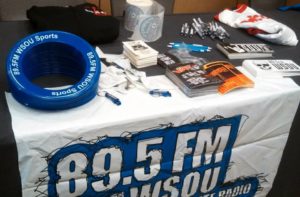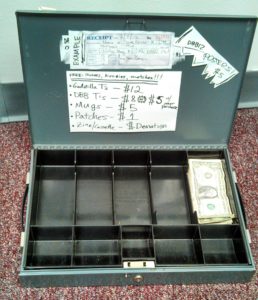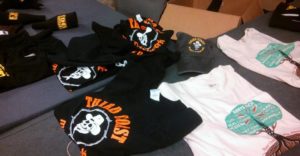May 4, 2016
Board Blog: How to handle station swag
Last Updated on May 4, 2016 by askcbiorg

[fusion_builder_container hundred_percent=”yes” overflow=”visible”][fusion_builder_row][fusion_builder_column type=”1_1″ background_position=”left top” background_color=”” border_size=”” border_color=”” border_style=”solid” spacing=”yes” background_image=”” background_repeat=”no-repeat” padding=”” margin_top=”0px” margin_bottom=”0px” class=”” id=”” animation_type=”” animation_speed=”0.3″ animation_direction=”left” hide_on_mobile=”no” center_content=”no” min_height=”none”]

Jamie Lynn Gilbert, CBI Secretary
College radio stations, as well as some college television stations, are known for their swag. From artistic T-shirts to coffee mugs to DIY zines and dubbed cassette mixtapes, stations have a lot to offer their audience merchandise-wise. If done correctly, merch can also be a big revenue generator. If done incorrectly, it can be a major headache for all involved. Here are some tips to start or augment a merch department, along with a guide for how to run a merch table at an event.
Decide what to offer
T-shirts are an easy first choice. They can be relatively cheap to produce and have a high markup value. The standard logo on a white or colored shirt will work, but don’t be afraid to mix it up. If you don’t have graphic designers or artists on staff, consider holding a contest for design submissions. Fans will be jazzed to see their work represented and you can offer free T-shirts as compensation. Be sure to have the creator sign a release form for the work.

Remember not everything has to be a Hanes Beefy Tee! If your audience is more into American Apparel then go with a higher quality brand. Yes, it will cost more but you can also charge a higher price for it. Long sleeved shirts, hoodies and tank tops might also have appeal.
When you are ready to expand beyond T-shirts, there are countless options to consider: hats, earplugs, sunglasses, insulated lunch bags, water bottles, you name it. Because it would not be a board blog without a shameless plug, come to CBI’s National Student Electronic Media Convention Oct. 20-22 in Philadelphia (registration is now open!) and check out our moderately famous “Swag Swap” and social where radio, video and multimedia operations from across the country display their best stuff.
Buy a cash box and a receipt book

If you are going to sell station merchandise, you need to keep track of that cash! Buy a cash box and, if possible, keep it stocked with 50, $1 bills. There is nothing worse than having to turn paying customers away because they only have a $20 and you don’t have any change. The cash should not be used for anything else and every time you make a deposit, leave the $50 in the box. You will also need a receipt book. This is primarily for your internal recordkeeping, but sometimes a customer will request a receipt so it helps to have a book with carbonless copies. I personally recommend the Adams brand SC1182 money/rent receipt book. Teach everyone working the merch table how much detail you need on each receipt.
Make a price list
Stickers, buttons, key chains, pens and other swag bought in bulk are typically giveaway items. A good rule is if something cost you more than $2, you should probably sell it to recoup some of the costs. Once you decide what items you are selling and for how much, WRITE IT DOWN! A number of staff might handle your merch sales and you cannot expect them to remember prices. Printed price lists also help cut down on confusion at concerts or other events where talking can be difficult. If you allow staff to purchase some merchandise at a reduced price, write that down too.
Count everything – twice

If you are selling merch at an event, count exactly how many sellable items you are taking. If you have T-shirts, write down how many you have of each size. At the end of the event, count everything again. If you sold two small T-shirts and three mediums for $10 each, that means you should have an extra $50 in your cash box. Having reliable pre- and post-event numbers will save you a great deal of frustration if your merch workers skipped any receipts or didn’t write the size of the T-shirt sold. This will also help you keep accurate count of exactly how much you sold to report as taxable income to your University accounting office.[/fusion_builder_column][/fusion_builder_row][/fusion_builder_container]








